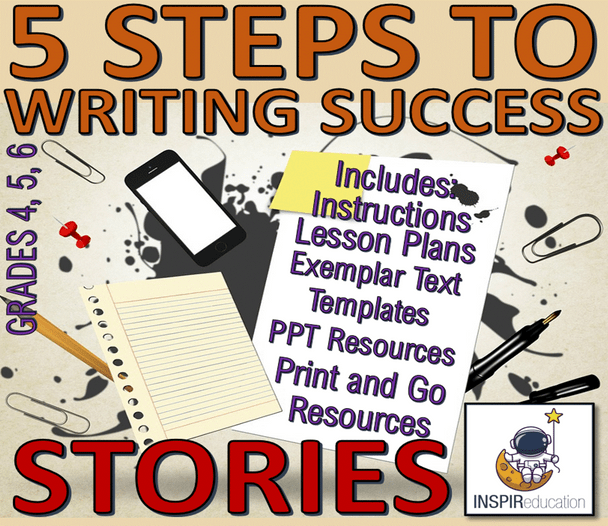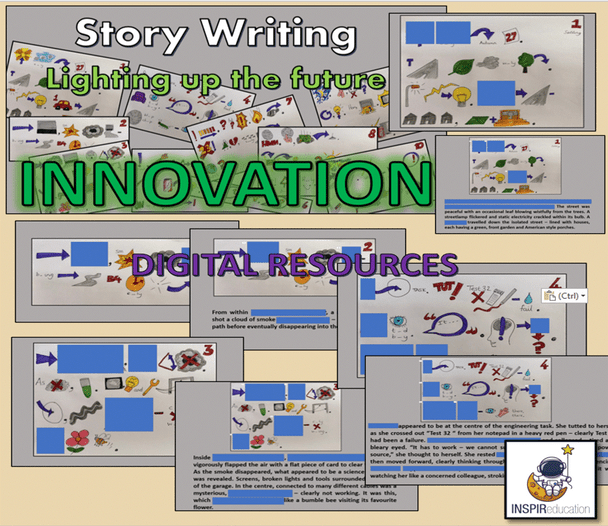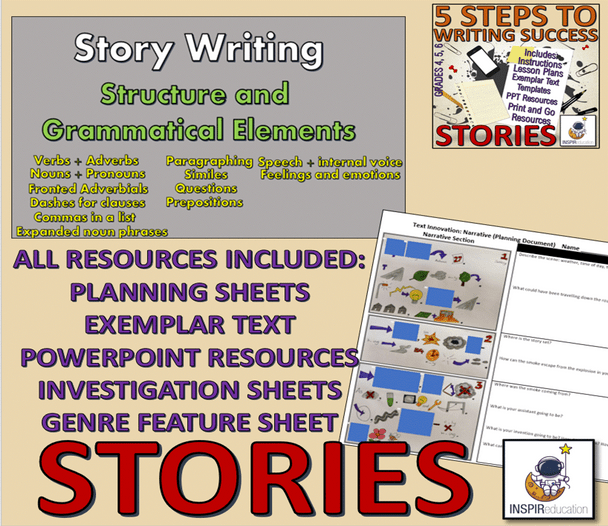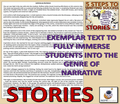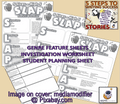Description
Welcome to our innovative package for making all students successful in writing stories within the narrative genre of writing. Tried and tested in the classroom, we have put together a sequence of five steps which will support all students master the skills required for writing in a specific genre. What’s more, it is easy to implement, the resources are all included within the product and the planning supports the teacher in ensuring the steps are met in their own time framework.
- Step 1 - Immerse and Engage
- Step 2 - Compare and Evaluate
- Step 3 - Model and Practice
- Step 4 - Replicate and Innovate
- Step 5 - Application and Independence
Each step is not time based, but flexible for the needs of your students - moving on when they are ready to embrace the next stage in their writing development. Full and detailed lesson plans will take you through each stage with a range of activities and full compliment of resources to support your needs and the needs of your students.
This product includes the all the resources you need to make writing stories a success:
- Full instructions and guide to each Step in the writing process
- Lesson Plans to take your students from introductory session to mastery of writing a short story*
- An exemplar story for analysis and evaluation
- PowerPoint resource which takes each paragraph of the story and illuminates the grammar skills included within it to ensure this is modelled and highlighted to students - ensuring teachers get every teaching point from the model text
- Structure, Language, Audience and Punctuation Analysis form for stories
- Completed Structure, Language, Audience and Punctuation Analysis form
- Blank Structure, Language, Audience and Punctuation Analysis form
- Writing frame for stories (blank)
- Classroom poster for Step by Step process to writing
- PowerPoint Presentation of the narrative transformed into a visual representation for students to learn
- Student copy of narrative visual representation to support learning the story
- PowerPoint Presentation demonstrating how to innovate the text to create a new story
(*Planning identifies which resource to use and when, with who and how)
The story element used to develop your student's writing skills is based on an environmental theme. In a suburban garage, and engineer is working on developing a machine which can take household waste and recycle it into power to enable the lights in the neighborhood to be powered. Not just that, but power beyond the locality - to save the world! With her trusty robot to help her, our main character will take your students through creating a setting where the main character is introduced as well as describing the locality, introducing the problem of the machine not working, moving through the conflict - which is frustration on behalf of our main character at the invention not working as it should, to complication, crisis and finally resolution where the initial problem is solved.
This product, with its original story, teaching plans and wide variety of both digital and paper based resources will allow your students to learn the features of narrative writing, talk the story, innovate the story and then create their own version of the story.
This product includes everything you need to teach the writing of adverts to your students. The resource works as a cumulative approach to writing:
Step 1 - Immerse and Engage
- Using provided model text, students read exemplar within the genre being studied.
- Immerse students within the world of the genre
- Engage students in reading and thinking about how the writing achieves its’ own aims and objective
Step 2 - Compare and Evaluate
- Using the “5 Steps, High 5 SLAP”, students to compare texts from the same genre looking for the similarities in features. The SLAP is an acronym for the features which they should be able to find:
- S = Structure (How is the genre put together from beginning to end in terms of structure?)
- L = Language (How is language used to create specific effects? What type of language skills are employed? What do we need to learn in order to be able to use this genre in our own writing?)
- A = Audience (Understand the needs of the audience. Who is the genre written for and why? In understanding this, writing will be more focused to their needs and achieve the outcomes we set for our writing)
- P = Punctuation (What punctuation has been used and why? What do students need to master in order to be able to use in their own writing and replicate success?)
Using the digital resources provided, students can investigate each paragraph for the punctuation and grammar used and how it impacts on the quality of the writing.
Step 3 - Model and Practice
With a clear understanding of the features and patterns of the genre being studied, the teacher then models how to write another exemplar text, engaging the students in choices being made. Following the High 5 SLAP and using it as a checklist as writing, the teacher models how to recreate a high quality piece of text which meets the needs of the audience and the task.
Following a modeled text, a shared text can be initiated, where students tell the teacher what to write. At this stage, students can use individual whiteboards to structure the features and the teacher can select the best examples, explaining why they have made those choices – or use the student suggestion to take an idea that can be further improved and show how this can be done.
Using the digital resources, this will demonstrate to students how they can take an existing story and innovate it to make a new story.
DISPLAY is vital for promoting high quality writing. Exemplars, modelled and shared texts should be displayed around the classroom. If the teacher models on the Interactive Whiteboard – print them off, blow them up and display in the classroom alongside the High 5 SLAP so that students are continually reminded of which features are included and how the features are included within the text.
Displays become a point of reference supporting all writers in their developing journey. The classroom therefore becomes like a workshop of creative ideas to pick and choose from. Students will feel supported and this will be reflected in the quality of their writing.
Using the High 5 SLAP, specific features for both language and punctuation can then be taught in standalone sessions, or within the genre study – ensuring students can apply the skills in their own writing.
Step 4 - Replicate and Innovate
Use teacher led/student agreed writing challenges, students can then work in groups to create their own written piece – discussing how to include the features within their writing from the High 5 SLAP. They have been immersed in the genre, had the writing modelled. This is when students will use the displays around the room and discuss choices in structure, language, audience and punctuation – taking ideas from one or all of the exemplar texts in order to make their writing more personal to them.
Students should be offered opportunities to read back their writing to the group – then discuss the strengths – referring back to the features identified in the High 5 SLAP. Areas for improvement can also be addressed at this point – but should be called something with a positive spin, e.g. Ways Forward, Next Steps, 3 stars and a Wish (3 positive points and one next step) etc. This enables all writers to see the process as a journey, and will learn to edit their writing to improve – without feeling bad that their writing isn’t “good” yet!
As with other exemplars – display the writing of the students around the classroom at this stage. It allows students to value their own writing and the writing of others. Its share an implicit message that their writing is worthwhile – it is valued and it is on the road to success within that particular genre.
Step 5 - Application and Independence
Students are now ready to apply the skills they have learnt within their own, independent writing. Using the planning sheet provided, students can use the displays around the room, the checklist of features and their own ideas to support the writing process. At this stage, students will believe that they can do it, and know they have the support around them to achieve well.
When completed, students can then read out their stories and their peers can review the success of each story heard, as well as evaluating which of the features have been included.
NB Each step is not one lesson or one day, but the time required for each step is reliant on the needs of the students to master each of the elements and have the knowledge and skills from each step to be able to successfully achieve that step and engage with the next. The pace of learning is therefore reliant upon the teacher knowing their students and the accuracy of the writing undertaken in each of the steps. The plan on the following pages will not make reference to time, but provide a suggestion for activities in order to acquire the skills within the writing genre.
This product and the steps, resources and planning worked in raising the standards of writing across our phase. We believe it can do the same for your students too! We are hoping to provide more genres in the future once we have tested them on our students in a range of non-fiction genres - so your feedback would be invaluable!
Best wishes
INSPIReducation

